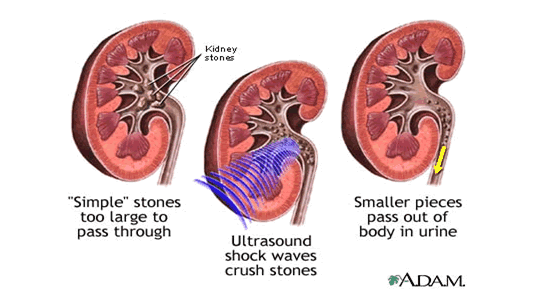General Information
Lithotripsy is a technique that uses shock waves to break up stones that form in the kidney, bladder, ureters, or gallbladder.
There are several forms of lithotripsy. The most common is extracorporeal shock wave lithotripsy (ESWL). Extracorporeal means outside the body.
You will usually be asked not to drink or eat anything for several hours before the test. Before the test is scheduled, tell your health care provider about any medicines you take. You may be asked to stop taking aspirin, ibuprofen, coumadin, and any other drugs that interfere with blood clotting several days before. You should tell your doctor if you are pregnant, because lithotripsy must not be performed during pregnancy.
The health care provider will use x-ray or ultrasound images to see where the stones are. High-energy shock waves, also called sound waves, pass through your body to the area on the kidney stones. You may feel a tapping sensation when this starts. The waves break the stones into tiny pieces. It is easier for smaller pieces to pass out of the body during urination. The procedure generally takes from 45 minutes to 1 hour.
ESWL is an alternative to surgery that is sometimes needed to remove stones from the kidney or ureter. Because ESWL requires no cutting, you have less pain and a quicker recovery. An overnight hospital stay is usually not needed.
While most kidney stones are treated with ESWL, not all stones can be treated this way. Sometimes a laser is used. When a laser is used, the doctor must use an endoscope, which is a tube introduced into the body, via the urinary tract, to get close to the stone. This usually requires general anesthesia (asleep, no pain), but you may go home the same day. Laser lithotripsy may be done if stones do not go away with ESWL, if they can’t be treated with ESWL, or if you can not have ESWL for some reason. Laser lithotripsy carries a slightly greater risk of complications than extracorporeal shock wave lithotripsy.
The doctor may also access the stone from your back into your kidney, through a procedure called percutaneous lithotripsy. This is a more complicated procedure, and is only used for large kidney stones.
Recovery
After the procedure, you will stay in the recovery room for up to about 2 hours. If you had percutaneous lithotripsy, you will need to stay in the hospital overnight.
It is extremely important that you have someone drive you home from the hospital. You should rest when you get home. Most people can fully resume daily activities within one or two days after ESWL. It can take a little while long to recovery from laser and percutaneous lithotripsy.
You should drink plenty of water in the weeks after treatment. This helps pass any remaining pieces of stone and prevents them from coming back. You may have pain and nausea when the pieces pass. This can happen soon after treatment and may last for up to 4-8 weeks. Taking a painkiller and drinking lots of water will help relieve symptoms. It is normal to have a small amount of blood in your urine for a few days to weeks after the procedure.
Depending on the type of lithotripsy, you may need to take antibiotics and anti-inflammatory medicines for a few days. If the stones are in your urinary system, you will probably be asked to strain your urine at home to look for stones. Any stones that are found can be sent to a medical lab for examination.
You will be asked to visit your doctor for a follow-up appointment in the weeks following the lithotripsy. (For example, this might include a kidney x-ray to determine if kidney stones are still present.)

